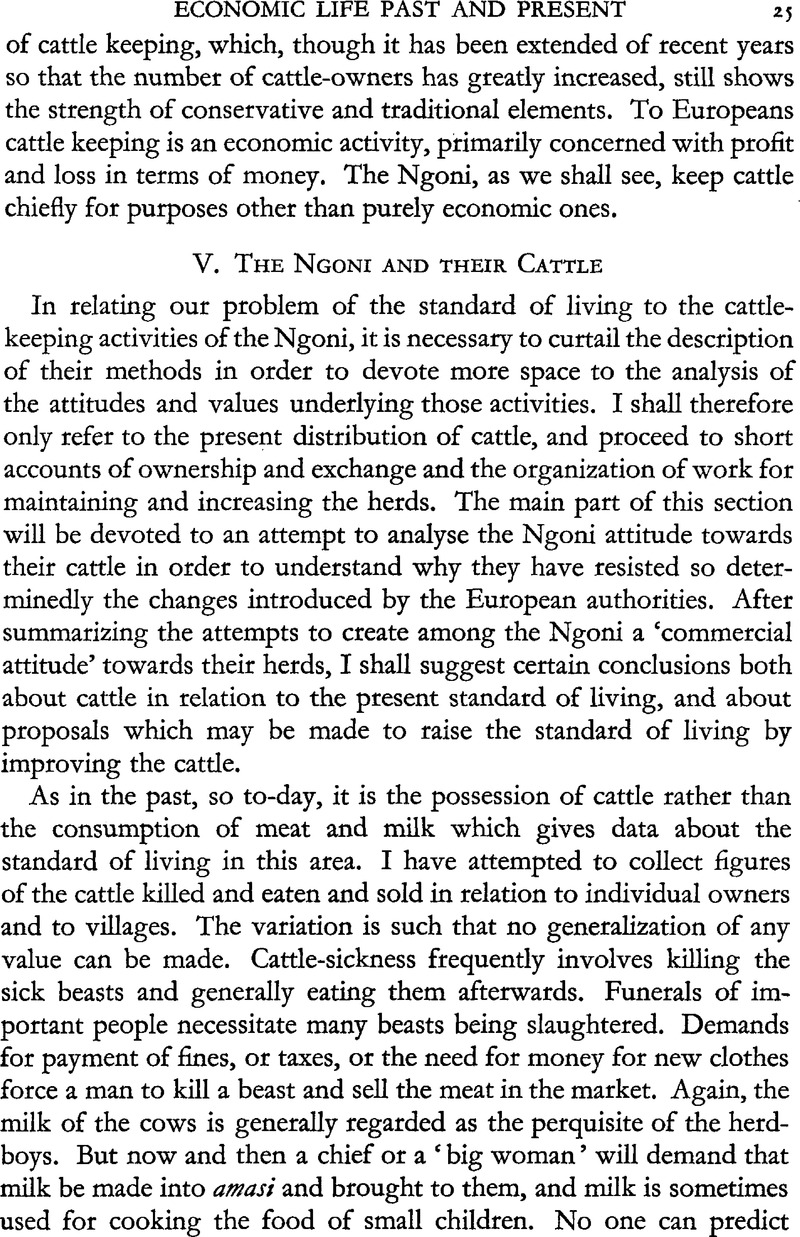Article contents
V. The Ngoni and their Cattle
Published online by Cambridge University Press: 21 August 2012
Abstract

- Type
- Native Standards of Living and African Culture Change
- Information
- Copyright
- Copyright © International African Institute 1938
References
page 26 note 1 A kraal in Nyasaland is a cattle enclosure—a circular space fenced in by high stakes 10-12 feet high and varying in size according to the number of cattle. The term kraal is not synonymous with village as it is in the south, and there are frequently several kraals in one village.
page 26 note 2 6s. a month is the unskilled labourer's wage. Domestic servants get 10s. to £1; clerks 15s. to £3.
page 26 note 3 In the Dedza and Ncheu Districts (of which about half is in the Highlands) the total money orders and postal orders paid in 1935 were £7,454 and £6,416, respectively.
page 28 note 1 The small herd-boys of to-day who are 7-15 years old cannot do much in the way of protection, but they must report any spoor of a lion, &c.
page 29 note 1 Muhlale kahle, the usual greeting.
page 28 note 2 Indaba yako.
page 30 note 1 A reference to the removal by British troops of about half the herds after the Ngoni war of 1896.
page 30 note 2 It was the privilege of the ‘big women’ to ‘guard the spirits’ by keeping in their huts the ritual vessels for sacrificing. Thus these ‘big houses’ which were the units for economic organization were also the focus points for religious ritual.
page 30 note 3 This is the accepted tradition.
page 31 note 1 Sosola, a Chewa chief, was anxious to move the Ngoni out of his area, so he sent them a parcel of dung, saying, ‘There is more where this came from.’ Actually t i was buffalo dung, but the Ngoni took the bait and crossed the southern end of Lake Nyasa, not finding any cattle, however, until they reached Songea.
page 31 note 2 This is the substance of many conversations on this subject with accredited informants.
page 31 note 3 These Ngoni cremate their Paramount Chief, and other notables, men and women, are buried on the edge of the cattle kraal.
page 31 note 4 ‘For we know that these things [i.e. witchcraft and magic] cannot cause the life of man to fail, nor can they preserve it, but they are all worthless and therefore to be despised.’ (From an Ngoni text on the magic used by the conquered tribes.)
page 32 note 1 See p. 27 for inheritance of cattle.
page 33 note 1 One of the most, often-heard descriptions of the old serfdom is, ‘Were they not our children? Did we not pay cattle for them in cases and give them cattle to lobola their wives?’
page 33 note 2 The lobolo varies from I to 6 beasts. Only in pre-European days were the daughters of chiefs lobola'd for 10, 12, or 15 head of cattle.
page 33 note 3 Europeans.
page 34 note 1 Except in cases, as already cited, where a commoner ‘marries up’ by giving lobolo for a bride of high rank.
page 34 note 2 See footnote 2, p. 19.
page 35 note 1 Annual Report of Provincial Commissioner, 1935.
page 35 note 2 Referring to the events of the war of 1896.
- 1
- Cited by




